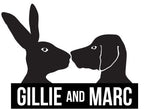A Wild Life for Wildlife on the WTC Campus
Published June 2023
The outdoor art installation, A Wild Life for Wildlife, brings a fun, whimsical experience to the World Trade Center campus through three large bronze sculptures. The yearlong installation provides awareness of global conservation issue and public engagement for the hundreds of thousands of daily campus visitors and community residents.
The exhibit’s sculptures depict the following:
They Were On a Wild Ride to a Safer Place With Rabbitwoman and Dogman: Visitors can hop on a giant tandem bike in the city with some of the most endangered animals in the world.
The White Rhino Was Thinking Ahead with Dogman's Encouragement: The public can join an intensive game of chess between a white rhino and Dogman, one-half of the artist's iconic hybrid duo.
The African Elephant Never Forgot What He Learned and Neither Did Rabbitwoman: The African elephant and Rabbitwoman duo enjoy sharing knowledge and learning. They sit together, reading a book over coffee, inviting the public to sit and join the conversation.

We reached out to the artists, Gillie and Marc, to learn more about the sculptures, their inspiration and creative process.
1. Can you tell us about yourselves?
We’re Gillie and Marc, a husband and wife artistic duo from Australia (Marc) and the UK (Gillie). Our unifying mission is to fill the world with inspiring public art that spreads messages of love, equality, conservation, and hope. As public sculpture artists and wildlife activists, our method is to put wildlife front and center in cities across the planet, making unforgettable experiences and recreating connections with the wild world. We aim to inspire a community that passionately works for change and unity so we can all live in a better world tomorrow.
2. Where does your inspiration stem from to create your animal sculptures?
Every time we create a large-scale wildlife public sculpture our number one aim is to help people to fall in love with wildlife. As we were brainstorming ideas for this particular project, we wanted to bring [to the forefront] the very serious issue of the extinction crisis and allow the public to touch, play, and encounter wildlife in a way they never could in real life. Each of these sculptures is showing wildlife in a setting we could find ourselves in on a regular day. By showing them in these scenes we hope to normalize the idea of having wildlife as a part of our world rather than being a separate, far-off reality.
3. What do you hope visitors walk away from the sculptures feeling?
We hope that people will begin to understand the extent of the extinction crisis and how quickly it is happening. But more importantly, we hope they understand that they can make a difference, even if they’re far away from many of these animals. Every loss affects every living thing, even if it’s on the other side of the world. We must stand together and protect all wildlife. But at the same time, we hope they leave after having fun!
4. How did you decide to exhibit your sculptures at the World Trade Center?
Our sculptures are most effective when they are in very prominent places, reaching thousands of people as they go about their everyday lives. The World Trade Center is one of the most iconic corners in all of NYC, with a lot of foot traffic as well as an emotional past. We thought this would be a perfect backdrop to share the joy of being wild while educating about the very real threat of extinction. We were thrilled when the exhibition was accepted.
5. What is the process of making these sculptures?
The key is in the initial character study. We can’t explain how many hours we’ve spent studying and sketching many, many different animals over the years. We have regular trips to different parts of the world to see animals up close, watching how they move and interact with their environment. Once we have an idea for a sculpture, we refer back to the studies we’ve done in the past. From these, we style the position and the expressions of each animal, trying to make them as close to reality as we can. But for these sculptures, the stance is a bit different. While the expressions and physique are realistic, the poses are very human. This was a lot of fun, transforming their bodies into completely different positions to what we would normally create.
This is then copied over into the mould to be cast in bronze. It’s a long process but the detail is crucial.
6. What are your favorite animals?
It’s such a tricky question, but we would have to say rhinos; they have an extra special place in our hearts. This love affair began during a project memorialising a black rhino and her calf who mysteriously died in a zoo in Australia. We were heartbroken by this tragedy and wanted to create an artwork that would not only remember the rhinos but also raise awareness about conservation. This sparked a fire that led to us learning all we could about rhinos, trying to find a way to give a voice to the voiceless, and help people to understand the urgency for the conservation of these beautiful animals. That then led to us going ‘rhino crazy’, creating the largest rhino sculpture in the world for the famous Sculpture by the Sea then beating our record with The Last Three which was unveiled in Astor Place in NYC the following year.
7. Where will the sculptures go after their year at WTC?
Stay tuned for the next stop in 2024!
Be sure to stop by and take a photo with the public art installation! It will be on the WTC campus until May 2024.

